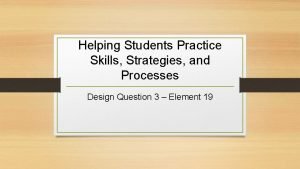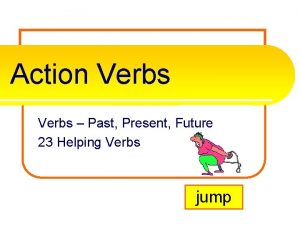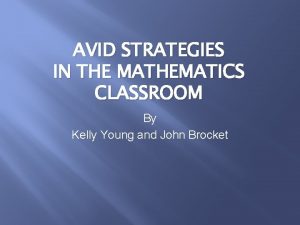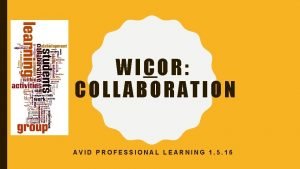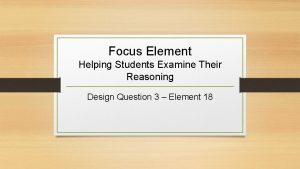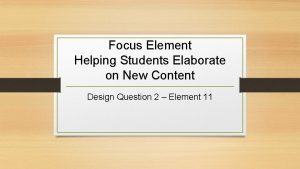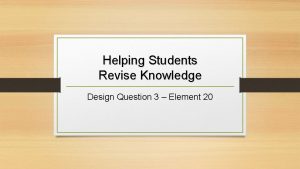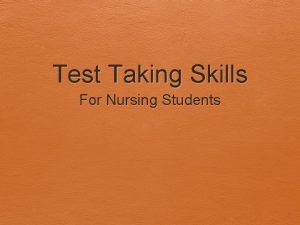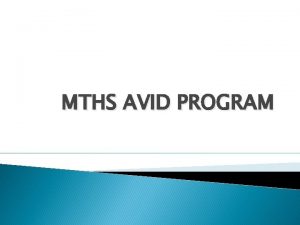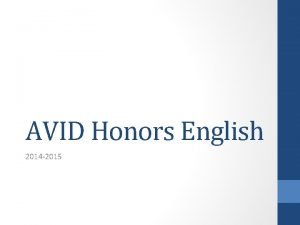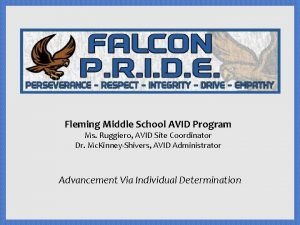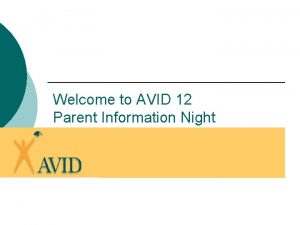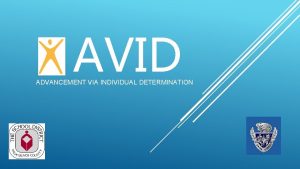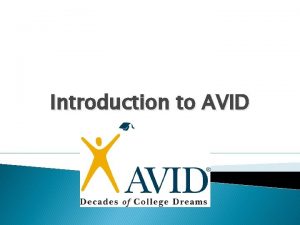AVID Strategies at a Glance Helping ALL Students













- Slides: 13

AVID Strategies at a Glance Helping ALL Students Succeed

Cornell Notes • Cornell Notes were developed in 1949 by Walter Pauk, a law professor at Cornell. • Good C-Notes help students organize and process information and use critical thinking skills. • By learning note-taking strategies, students gain access to the “hidden curriculum” of education – learning note-taking skills is part of learning how to do school.

2 Topic/Objective: Essential Question: Questions/Subtitles/ Headings: 5 Summary: 6 Name: Date: 3 Notes: 4 1

Topic/Objective: Elements of a short story 2 Name: Amanda Hines Date: April 5, 2012 1 Essential Question: What are the defining characteristics of a short story? Questions/Subtitles/ Headings: *What are the parts of a story plot? *What are the 5 different types of conflicts? *What are some types of characters? 5 3 Notes: -plot = events that take place in a story -parts of a plot are exposition, rising action, climax, falling action, resolution -conflicts: person vs. person = between 2 people person vs. nature = natural disasters person vs. society = mainstream society person vs. self = within heart/soul/mind person vs. supernatural = a supernatural entity -dynamic character = personality changes throughout story -static character = personality does not change thru story no matter what happens 4 6 Summary: We are learning the major elements of a short story. The structure of a short story is made up of the different parts of a plot, beginning with the exposition and ending with the resolution. We have also reviewed the types of conflicts that are commonly used, as well as the difference between static and dynamic characters.

WICOR Strategies Writing Inquiry Collaboration Organization Reading WICOR leads to Rigor…

WICOR Writing Strategies • Cornell Notes • The Writing Process, from Pre-Write to Final Draft • Learning logs/Reflection journals – What did you do in class today/this week? What did you find interesting? What could you have done differently as a student? • Focused Writing – Write nonstop for 5 -10 minutes on a specific topic being studied. The purpose is to explore new ideas, find out what you know and still need to learn about the topic. • Quick Write – Write for 1 -2 minutes about a topic.

WICOR Inquiry Strategies • Socratic Seminars – A dialogue, usually centered around a text, different formats (inner/outer circle, wingman) • Philosophical Chairs – A debate, usually centered around a yes/no “hot-button” issue. Students choose their own side, or are assigned to an opinion and have to argue it, whether or not they agree. – Format varies (stand on opposite sides of room for yes/no, stand around room in spectrum from “strongly agree” to “strongly disagree”) • Critical Thinking Activities – Logic puzzles and riddles

WICOR Inquiry Strategies, cont. • Using/Writing High Level Questions – Using Bloom’s Taxonomy or Costa’s Levels of Questions • Costa’s Level 1: Knowledge/Recall – What is a gene? What is a chromosome? • Costa’s Level 2: Processing – Compare and contrast genes and chromosomes. • Costa’s Level 3: Synthesize/Hypothesize – Use what you know about genes and chromosomes to predict a trait in a child. • Gallery Walk – Set up topical quotations, pictures, questions, words, (almost anything!) around room. Students circulate in groups and write their reflections either on posted chart paper or in their own notes.

WICOR Collaboration Strategies • Jigsaw Activities – Groups of students become “specialists”, bring knowledge back to original groups to accomplish a task • Think-Pair-Share – Reflect on a topic, find a partner, share thoughts • Study Groups • Socratic Seminars • Philosophical Chairs

WICOR Collaboration Strategies, cont. • Tutorials – AVID Tutorials are structured to use the Socratic method and encourage active learning in small groups. Students question each other to arrive at the answer instead of giving knowledge. – Tutor is the “guide on the side”, not the “sage on the stage”. • Reciprocal Teaching – A group of students read a text together piece by piece and, through discussion, help each other understand the content. – Students use 5 key strategies: summarizing, predicting, clarifying, questioning, and visualizing. – Appropriate for all content areas, texts, and allows for full student participation regardless of reading ability.

WICOR Organization Strategies • Student agendas/planners – Students write assignments for each class each day. Students self-monitor completion of assignments. • Student binders – Dividers for each subject, Cornell notepaper. – Pencil pouch with pencils, pens, highlighters. – No loose papers!

WICOR Reading Strategies • SQ 5 R (Survey the text/Question the material/Read to answer questions, Record key ideas, Recite answers to questions, Review your notes, Reflect on the text) KWL (What I Know/Want to Learn/Learned) • • Marking the text – – Number the paragraphs for common reference Circle key terms Underline the author’s claims Highlight new vocabulary • Write for Discovery as you Read – Post-It notes, Letter from/to a character, Letter to author, Reader’s Response Log • Reciprocal Teaching

WICOR Strategies Writing Inquiry Collaboration Organization Reading WICOR leads to Rigor…
 Marzano element 19
Marzano element 19 All 23 linking verbs
All 23 linking verbs Wicor partners
Wicor partners Avid kwl chart
Avid kwl chart Wicor avid definition
Wicor avid definition Marzano helping students examine their reasoning
Marzano helping students examine their reasoning Helping students examine their reasoning
Helping students examine their reasoning Using questions to help students elaborate on content
Using questions to help students elaborate on content Helping students elaborate on new content
Helping students elaborate on new content Learning target
Learning target Helping students revise knowledge
Helping students revise knowledge Name all rays
Name all rays Why did rizal salute to luna and hidalgo
Why did rizal salute to luna and hidalgo Test taking strategies for nursing students
Test taking strategies for nursing students
